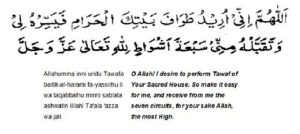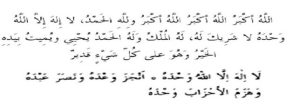Umrah Guide
- Introduction
- Kinds of Umrah
- Obligator Duties in Umrah
- Umrah Process
- Meeqats (Ihram Stations)
- Ihram
- Umrah For Women
- Umrah in Ramadan
- Dua's & Azkaar For Umrah
- Mistakes to Avoid During Umrah
- Useful Tips
Introduction to Umrah –(Holy Urge to the way to Allah )
The significance of Performing Umrah
“Possessor of The Pilgirmage”
Umrah holds an exceptional value and rewards in Islam that provide spiritual purity to every Muslim who performs it. However, unlike Hajj, it is not an obligation for a person; it is Sunnat-e-Muwaqada (highly recommended). Umrah was performed by Prophet Muhammad (PBUH) twice in his lifetime.
Umrah resembles Hajj on many levels and is often called “minor Hajj.” A pilgrim needs to perform Umrah before starting the rituals for Hajj, but it can be performed anytime during the year. There are innumerable virtues of doing Umrah correctly.
The Prophet (PBUH) said, “The accepted Hajj & Umrah has no other rewards, except Paradise.” He further said, “Umrah is expiation for the sins committed between it and the next, and Hajj, which is accepted, will receive no other reward than Paradise.”
Umrah is an act of spiritual purity for a Muslim who wants to perform it to earn the pleasure of Allah (SWT). It is a way to purify the mind and soul and provides inspiration for a lifetime. Allah (SWT) gives a reward for every good deed performed in his way, and when a believer spends his time and wealth for His sake, He saves him from mishaps and misery. The blessings of performing Umrah are immense.
According to a Hadith narrated by Ibn Abbas (RA), Allah’s Messenger (PBUH) said,
“Perform Hajj and Umrah consecutively; for they remove poverty and sin as bellows removes impurity from iron.”
One of the other benefits of performing Umrah is that a pilgrim also gets a chance to visit Madinah- the city of our beloved Prophet (PBUH), and do ziyarat of all the places related to Prophet Muhammad (PBUH) and his companions, including Mosque Quba, Masjid-e-Nabawi and Jannat-ul-Baqi.
Now that you have decided to perform Umrah, you should acknowledge the nature of Allah’s blessings and how fortunate you are to be called to the House of Allah. Be grateful for the opportunity that occurred in time, and you can afford it.
What are the Different Methods/Forms of Performing Umrah?
Umrah is a lesser form of Hajj that is not obligatory on an individual but a preferred Sunnah. It is a beautiful form of worship that takes you closer to Allah. If you get a chance to go for Umrah & perform the Umrah rituals, acknowledge the fact that it is a great blessing that the Almighty has bestowed upon you. Umrah was performed twice by Prophet Muhammad (PBUH) in his lifetime. It is a spiritual journey that has many rewards in this life and the Hereafter.
There are two types of Umrah:
Umrah-ul-Mufradah: This form of Umrah is performed all throughout the year except on the days of Hajj. It is independent of Hajj and performed at any time of the year.
Umrah-ul-Tamattu: This form of Umrah is performed in conjunction with Hajj during the time of Hajj but before the commencement of Hajj rituals, i.e., before the 8th Dhul Hijjah.
Note: There is no difference in the procedure of the two kinds of Umrah pilgrimage. In both Umrah-ul-Mufradah and Umrah-ul-Tamattu, it is obligatory to assume Ihram at the Meeqat. If a person is in Makkah and intends to perform Umrah-ul-Mufradah, it is permissible for him to come out of Haram to assume Ihram and not move to meeqat. He can wear Ihram at Hudaybiyyah, Ja’ranah or Tan’eem.
Obligations and Important Acts of Umrah
There are four essential rites of Umrah, out of which are Fard (obligatory) and Wajibat (essential). These compulsory acts in Umrah are as follows:
1. To assume Ihram at Meeqat, which is accomplished after a person recites Talbiyah with the intention of Umrah [Fard]
2. To perform Tawaf [Fard]
3. To perform Sa’ey between the hills of Safa and Marwah [Wajibat]
4. Have the head shaved (for men) or hair cut short (for women) [Wajibat]
Step by Step guide to Umrah
Preparing for Umrah:
“Submit physically in the way to Allah”
Hygiene and cleanliness are the most important things while preparing for Umrah. Before embarking on this sacred journey, pilgrims must take bath (ghusl) after properly trimming the nails and shaving hair from private parts. Male pilgrims should also trim their moustache. Women are allowed to wear Henna and some jewellery but it is better to stay away from such superficialities. After completing the purification of body, you must offer 2 Raka’t nafl prayers before assuming Ihram.
Reaching Meeqat and Assuming Ihram:
Ihram is more than just a dressing, it is to enter into a state in which certain halal things are prohibited after forming niyyah (intention) such as wearing stitched clothes (for men), using perfume, haircut etc. Every male and female pilgrim must assume Ihram before reaching Meeqat (stations for assuming Ihram). Male pilgrims are required to wear the two unstitched white sheets whereas women can wear simple stitched clothes. Now you can declare your intention for Umrah by reciting:
اَللَّهُمَّ نَوَيْتُ الْعُمْرَة وَاحْرَمْتُ بِه فَتَقَبَّلْه‘ مِنِّیْ
(O Allah! I intend to perform Umrah. Make it easy for me and accept it from me.)
It is difficult to change into Ihram on the flight. Pilgrims travelling to Makkah from other countries should wear it from their departing airports. However, you must declare the intention after reaching Meeqat. After reaching Rabigh which is a Meeqat for pilgrims arriving from the UK, you must state your intention by reciting the following dua:
اَللَّهُمَّ اِنِّیْ اُرِيْدُ الْعُمْرَة فَيَسِّرْهَالِیْ وَتَقَبَّلْهَا مِنِّیْ وَاَعِنِّیْ عَلَيْهَا وَبَارِکْ لِیْ فِيْهَا نَوَيْتُ الْعُمْرَة وَاَحْرَمْتُ بِهَا ِﷲِ تَعَالٰی
After reciting this prayer, you have assumed the state of Ihram which will remain so till the end of your Umrah. Your intention of performing Umrah should be pure only for the sake of Allah and not because of a desire to impress others. You must not miss your regular prayers (five times a day).
It must be noted that King Abdulaziz International Airport is not the Meeqat and pilgrims should not make the mistake of assuming Ihram at the airport. Ignorance on the part of pilgrims may result in the penalty of Dam. An animal should be sacrificed as a penalty if pilgrims make the mistake of assuming Ihram at the airport. Only the natives of Jeddah can officially start their Umrah from here. Follow the previous dua with the Talbiyah which is an announcement of the previous declaration.
لَبَّيْکَ اَللَّهُمَّ لَبَّيْکَ، لَبَّيْکَ لاَ شَرِيْکَ لَکَ لَبَّيْکَ، اِنَّ الْحَمْدَ وَالنِّعْمَة لَکَ وَالْمُلْکَ، لاَ شَرِيْکَ لَکَ-
(Labbaik Allahumma Labbaik)
Men are required to recite the Talbiyah loud whereas women can say it with low voice. Talbiyah should be recited three times with utmost respect and often repeated during the Umrah. Also, it is the best to memorize dua for Umrah with their translations before leaving for the journey.
On witnessing Kaa’ba for the first time:
Enter Masjid Al Haram with your right foot and recite the following dua:
اللَّهُمَّ صَلِّ عَلَى مُحَمَّدٍ وسلم, اللَّهُمَّ افْتَحْ لِي أَبْوَابَ رَحْمَتِكَ
(In the name of Allah and Salat and Salam upon Rasulullah .O Allah! Open to me the gates of Your Mercy)
Take the moment to savor the sight of the Kaabah and its magnificence when your first gaze falls upon it. Be grateful to Allah (SWT) for the opportunity and say aloud three times in a row:
الله أكبر لا إله الا الله
This is a special moment when it is likely for prayers to be accepted so make dua and ask Allah for anything that your heart desires.
Performing Tawaf or circumambulation of the Kaaba:
The Tawaf must be performed in the state of wudu. Before starting with Tawaf, make a slight change in the top piece of Ihram (male pilgrims only). Cover the left shoulder with one end of the Ihram and pass the other end under the right arm so that your right arm and shoulder is bared and left shoulder covered. This is called Idtiba. Now, proceed to the Hajr-e-Aswad, (the black stone) while reciting the talbiyah. The starting point of your Tawaf should be the brown line that runs from the Hajr-e-Aswad till the end of the Mataf (an open area for Tawaf). Stand facing the Kaabah with brown line on your right. Stop reciting talbiyah and make your intention:
“O’ Allah I intend performing Tawaf of your sacred house, (seven rounds) So make my Tawaf easy for me and O’ Allah accept it from me.”
Now stand on the brown line and facing the Hajr-e-Aswad with your face and chest in line with the black stone. Raise both hands as in Salah and recite the following:
“Bismilah allahu akbar, la ilaha illallah was lillahil hamd”
(In the name of Allah – Allah is the greatest. There is none worthy of worship besides Allah and all praise belongs to Allah)
Now, proceed towards the Hajr-e-Aswad and kiss it without harming anyone. If it is too crowded and you are unable to kiss the black stone, stretch your arms with the palms facing the Hajr-e-Aswad and recite, BISMILLAHI ALLAHU-AKBAR then kiss your palms as a substitute. To kiss or touch Hajr-e-Aswad is called Istilam.
Your Tawaf formally begins from here. Male pilgrims are required to perform the first three rounds of Tawaf at a brisk pace with the chest out (this is called ramal ) the last four rounds are to be performed at a normal walking pace. The Hatim (a low, half circle shaped marble wall close to the Ka’bah) has to be encircled as well or your Tawaf will be incomplete. Every time you circle the Kaabah, you should touch the rukn-e-Yemani (the Yemani corner) with your right hand, it is mustahab. Do not kiss it or place your forehead against it. If you are unable to touch it, move on with your Tawaf. Every time you reach the Hajr-e-Aswad perform Istilam. Complete the seven rounds in this manner.
After completing the Tawaf, make dua in soft voice. It is better to make dua in a language that you understand. There is no fixed dua for each round. You can recite any dua that you remember. The most recited dua by Prophet Muhammad (pbuh) and Sahabas to be recited between Rukn-e-Yamani and Hajr-e-Aswad was,
“Rabbana Aatina fiddunya Hasanah wa fil akhirathi hasanah wa qina azaban naar”
(Our lord! grant us good in the world and in the hereafter and save us from the fire of Hell)
Go to Multazam and make dua at your heart’s desire. The area between the door of the Kaaba and Hajr-e-Aswad is called Multazam. Prayers made at this point are likely to be accepted. Seek forgiveness from Allah (SWT).
Praying at Maqam-e-Ibrahim:
Afterward, move to Maqam-e-Ibrahim to offer 2 raka’t nafl salah if it’s not makrooh time. These two raka’t are wajib salah and the recommended Surahs are Al-Kafiroon and Al-Ikhlaas.
Zamzam Well
Move to the well of zamzam after performing the Salah at Maqam-e-Ibrahim. Drink zamzam to your fill and pour some over your head. Zamzam water purifies the body and soul. Prophet Muhammad (pbuh) would say the following dua before drinking zamzam:
“O’ Allah I am asking you for beneficial knowledge and extensive sustenance and a cure from all ills”
The zamzam well has been closed to the public now. You will see water coolers placed side by side in long rows. Pilgrims move to these water coolers to drink zamzam after their Tawaf.
Performing Saa’ee:
Performing saa’ee is an obligatory ritual in Umrah which can be performed only after completing Tawaf. There is no saa’ee without Tawaf or before it. Saa’ee begins from Safa and comprises of seven rounds between the hills of Safa and Marwa. When a pilgrim reaches the point marked with green pillar, he should start running with medium pace and then again resume the normal pace. This is called Ramal. Only men are required to perform Ramal. Women should walk with their usual pace.
Ascend the Safa and before starting Saa’ey make the intention by facing the Kaaba and reciting the following:
(O Allah! I intend to make seven rounds of Sa’ey between Safa and Marwah, for Your pleasure. Make it easy for me and accept it.)
Thereafter raise both arms whilst facing the Qibla and make a high-sounding call three times in a row:
اللّهُ أكبر, اللّهُ أكبر, اللّهُ أكبر
Pray to Allah as much as you can and make dua. This is the place for it. Ascend the Marwa Hill next. After reaching the Marwa Top, face the Kaaba and lift your hands to resound the call again three times:
اللّهُ أكبر, اللّهُ أكبر, اللّهُ أكبر
Complete the seven circuits in this way and end your Saa’ee at Safa – Marwa. After completing Saa’ee, it is recommended to perform 2 raka’t nafl prayers at Masjid-ul-Haram.
To finish the Umrah, men must shave their heads while women are required to merely cut their hair an inch shorter. Shaving or clipping of hair must be performed in the precincts of Haram. Now you can exit the state of Ihram and there is no more restriction.
Umrah Mubarak:
The entire stay in Makkah along with ziyarat of the Islamic sites like Masjid an-Nabawi, the Quba Mosque, Mount Uhud and Jannat-Al-Baqi allow for some of the most enthralling experiences. Always remember your worship of Allah is a direct reflection of your intention and it must remain pure. Do not engage in idle chitchat. Try to concentrate and devote your time in the remembrance of Allah.
Note: It is recommended to consult and seek an opinion from scholars on doubtful Islamic matters.
What are the Five Meeqat Locations for Umrah?
When and Where to Assume Ihram?
“Obliged Obligations”
Meeqats are prescribed stations for assuming the state of Ihram as set for Muslims by Prophet Mohammed (pbuh) on all the four sides of Makkah.A There are separate places of Ihram stations for Umrah/Hajj for people travelling from different parts of the world. These locations of Meeqat for Umrah /Hajj are as follows:
1. Al- Juhfah or Rabegh (For the people coming from Egypt, Syria, or the West)
2. Dhul-Hulaifah or Abyar Ali (For the people coming from Madinah)
3. Dhatul-Irq (For the people coming from Iraq)
4. Qarn-Al-Manazel (For the people coming from Najd and Taif)
5. Yalumlum (For the people coming from India, Pakistan and Yemen by Sea)
When to wear Ihram:
“Being in Holy Attire”
For pilgrims traveling by Air: From UK/ Europe:
Pilgrims traveling by air are required to wear Ihram before reaching the Meeqat, but they should make the intention (Niyyah) and call out “Talbiyah” only upon reaching the Meeqat following the announcement. (Saudi Airlines announce about Meeqat). If travelling by other airline, Meeqat zone comes approximately one hour before arrival at Jeddah Airport.
Note: It is not permissible for pilgrims to pass through these Meeqat places for Umrah/Hajj without donning Ihram irrespective of their mode of transportation; Road, Air or Sea.
How to Wear Ihram for Umrah? Ihram Clothing for Male and Female Pilgrims
“Symphonically Sublime Uniformity for Allah”
Ihram means the intention to enter a ritual and it is derived from the word ‘At-Tahreem’ which means entering what is prohibited. Therefore, as you enter the Ihram for Umrah , certain things become prohibited which were permissible before like sexual advances towards your wife, wearing fragrance, shaving the head, cutting hair, game hunting etc.
Ihram Procedure: How to wear Ihram for Umrah?
A person should wash himself thoroughly which includes removing hair from the private parts, trimming moustache or cutting of nails, before assuming the state of Ihram. A complete bath or ghusl should be performed. If you’ve already taken the bath then perform ablutions. Now take off your stitched clothes and change into the two white sheets of the unstitched cloth. Wear one sheet around your waist and drape the other one on your upper body. You can also wear a belt around your waist to fasten the cloth.
Women can wear regular stitched clothes. Ihram for ladies / women pilgrims includes a plain regular dress but most women wear an Abaya with Hijab. A woman cannot wear a veil around her face whilst in Ihram.
Offer 2 raka’t nafl, if it is not makrooh (undesirable) time, with your head covered before declaring the intention for Umrah. It is better to wear Ihram from home or airport and then declare the intention after reaching Rabigh which is a Meeqat for pilgrims who arrive from the UK. However those who are travelling to Madinah first should consider Madinah as their Meeqat. Again, it is better to declare your intention for Umrah after reaching the Meeqat.
Note: It is recommended to consult and seek an opinion from scholars on doubtful Islamic matters.
Can Women Perform Umrah Alone? What are the Rules of Umrah for Women?
Women can undertake Umrah like men but there are some rules regarding their journey of Umrah. They cannot go for holy pilgrimage and perform Umrah without a Mahram. According to the Islamic rule, a mahram is a male relative tied to a woman through blood, breastfeeding or relations after marriage. A person needs to be above the age of puberty to accompany a woman to Umrah as a Mahram. Also, performing Umrah with a fake Mahram is sinful. Go through the list of rules for female/lady pilgrims if you are planning to go on Umrah. We have tried to make a simple Woman’s Guide to Umrah for a hassle-free pilgrimage.
Here are some of the Umrah rules for ladies that they have to observe in the state of Ihram:
A woman in Iddah cannot perform Umrah. She needs to complete the waiting period and then go for Umrah with a Mahram.
According to the Saudi rules, an elderly lady can perform Umrah alone. A woman above the age of 45 can perform Umrah without a mehram but she is required to submit N.O.C from her mahram and must travel with an organized group.
Women should not perform Ramal (running with medium pace during Tawaf and Saa’ee) and should not say Talbiyah loudly like men.
If there is a large crowd of men near Kaabah, women should maintain a safe distance.
Women can offer nafl prayers after Tawaf anywhere in Masjid-ul-Haram if there is a rush at Maqam-e-Ibrahim.
Note: It is recommended to consult and seek an opinion from scholars on doubtful Islamic matters.
Blessings of Performing Umrah in the Month of Ramadan
“Sublime act in Devine days”
Performing Umrah in Ramadan carries immense value and religious significance. Umrah is considered a lesser form of Hajj and whoever performs Umrah with pure intention earns the highest pleasure of Allah (SWT). It is truly an enriching experience to see people from all over the world joined together in fasting and performing Umrah for the sake of their Lord Almighty. Virtues of Umrah in Ramadan can be understood by the following Hadith:
Al-Bukhaari (1782) and Muslim (1256) narrated that Ibn ‘Abbaas said: The Messenger of Allaah (peace and blessings of Allaah be upon him) said to a woman from among the Ansaar – Ibn ‘Abbaas mentioned her name but I forgot it – “What kept you from performing Hajj with us?” She said: We only have two camels and the father of her son and her son had gone for Hajj on one camel, and he left us the other camel so that we could carry water on it. He said: “When Ramadaan comes, go for ‘Umrah, for ‘Umrah in (that month) is equivalent to Hajj.”
In another Hadith, narrated by Ibn ‘Abbas (Radhiallāhu ‘anhu):
When the Prophet (Sallallāhu alayhi wa sallam) returned after performing his hajj, he asked Umm Sinan Al-Ansari, “What did forbid you to perform hajj?” She replied, “Father of so-and-so (i.e. her husband) had two camels and he performed hajj on one of them, and the second is used for the irrigation of our land.”
Prophet of Allah (Sallallāhu alayhi wa sallam) said (to her), “Perform umrah in the month of ramadan, (as it is equivalent to hajj or hajj with me (in reward).”
[ Sahih Bukhari – Book 29, Hadith 86 ]
The given Hadith clearly highlights the importance and benefits of Umrah in Ramadhan. It is considered the best time to perform Umrah and whoever performs it during the holy month of Ramadan gets the reward equal to a Hajj. However, it should be noted that performing Umrah in Ramadan does not discharge a person from the obligations of Hajj. Both the terms become equivalent in rewards but not in fulfilling the duty. Umrah is not obligatory whereas Hajj is compulsory for every Muslim if the person is capable of performing it.
Millions of Muslims from every corner of the world gather in the Grand Mosque to achieve closeness to Allah by fasting and worshipping together. It is truly a breathtaking sight when a sea of people breaks their fast during Iftaar with a common objective which is to connect to Allah (SWT).
Umrah is a spiritual journey and pilgrims travel to Mecca to seek the mercy of Allah (SWT) with their heart filled with love and gratitude. It is an enlightening experience for every believer, one that they would remember for a lifetime and be always thankful. Umrah is a blessing throughout the year but it holds special significance in the sacred month of Ramadan, an experience that every Muslim should try to accomplish.
Basic Umrah Dua –
A Guide to all the Supplications for Umrah
There are no special Dua or Supplications for Umrah, a person should recite any Dua he/she remembers and wishes. But one should try to perform the rituals of Hajj and Umrah as closely to how the Prophet (pbuh) performed. Here are some of most recommended and basic Umrah Duas and supplications that one should recite while on their journey for Hajj / Umrah:











Note: There is no specific dua for Saa’ee so recite any Dua from heart between the hills of Safa and Marwah.
Dua to recite when leaving Masjid-ul-Haram:

Useful Tips for Your Umrah Trip
The Arabic word ‘Umrah’ literally means to visit a populous place. Islamically, Umrah is a lesser form of Hajj, an act of worship which millions of Muslims do by visiting Makkah and performing the Umrah rituals as performed by our Prophet Muhammad (pbuh). Umrah is a non-obligatory form of worship which can be performed at any time all round the year except for the days of Hajj. Millions of Muslims visit Makkah to perform Umrah for the love of their creator, Allah (SWT) and to get spiritually connected to Him. It is essential to make this Umrah trip memorable so that it remains etched in our memories for a lifetime.
Here are a few quick and essential tips to make your Umrah journey outstanding and most memorable:
- Before planning your Umrah trip, ensure to get the necessary knowledge about the reason why you are undertaking this journey. Get an in-depth understanding of Islam from its authentic sources, Quran and Hadith. Learn more about the various fardh and Sunnah rituals of Umrah that you need to perform during your Umrah pilgrimage.
- Another must know Umrah tip is to make a list of all the Islamic sites that you are going to visit on your trip to Makkah and Madinah including Mount Uhud, Jannat-ul-Baqi, Masjid-e-Nabawi and Cave of Hira.
- Plan and arrange all your responsibilities at home and ensure that the provision for family is made well in advance before departing on Umrah pilgrimage to Makkah so that you concentrate completely on Ibadah.
- Another piece of advice before you leave for Umrah is to prepare your documents necessary for the Umrah travel. Make a copy of passport and other important documents, and email it to your personal I.D or store it on your Google drive or the like, in case something goes awry.
- Ensure that you learn about all the rules of Ihram before going on Umrah. There are simple rules that people can violate unknowingly or without thinking. For example you can’t use scented soaps and men cannot cover their head in the state of Ihram.
- Tips for Umrah travel also include talking to people from different countries and backgrounds. You will meet numerous Muslims from every corner of the world. Get enlightened about the message of brotherhood of our faith.
- Make a list of duas that you want to ask Allah (SWT). Make dua for yourself, your family and friends. You are at the most sacred place on earth worshipping the Almighty and your duas are more likely to be accepted if you do it with good intention and pure heart, In Sha Allah!
- One of the top tips to stay healthy during the Umrah pilgrimage is to eat fruits only after washing them including the dates. Avoid eating pre-cut fruits or salads which might have been exposed to unhygienic conditions.
Those were some of the most important tips & advice for going on Umrah. If you are planning to go to this spiritual tour, make sure that you remain prepared mentally and physically.
Useful Tips for Your Umrah Trip
The Arabic word ‘Umrah’ literally means to visit a populous place. Islamically, Umrah is a lesser form of Hajj, an act of worship which millions of Muslims do by visiting Makkah and performing the Umrah rituals as performed by our Prophet Muhammad (pbuh). Umrah is a non-obligatory form of worship which can be performed at any time all round the year except for the days of Hajj. Millions of Muslims visit Makkah to perform Umrah for the love of their creator, Allah (SWT) and to get spiritually connected to Him. It is essential to make this Umrah trip memorable so that it remains etched in our memories for a lifetime.
Here are a few quick and essential tips to make your Umrah journey outstanding and most memorable:
- Before planning your Umrah trip, ensure to get the necessary knowledge about the reason why you are undertaking this journey. Get an in-depth understanding of Islam from its authentic sources, Quran and Hadith. Learn more about the various fardh and Sunnah rituals of Umrah that you need to perform during your Umrah pilgrimage.
- Another must know Umrah tip is to make a list of all the Islamic sites that you are going to visit on your trip to Makkah and Madinah including Mount Uhud, Jannat-ul-Baqi, Masjid-e-Nabawi and Cave of Hira.
- Plan and arrange all your responsibilities at home and ensure that the provision for family is made well in advance before departing on Umrah pilgrimage to Makkah so that you concentrate completely on Ibadah.
- Another piece of advice before you leave for Umrah is to prepare your documents necessary for the Umrah travel. Make a copy of passport and other important documents, and email it to your personal I.D or store it on your Google drive or the like, in case something goes awry.
- Ensure that you learn about all the rules of Ihram before going on Umrah. There are simple rules that people can violate unknowingly or without thinking. For example you can’t use scented soaps and men cannot cover their head in the state of Ihram.
- Tips for Umrah travel also include talking to people from different countries and backgrounds. You will meet numerous Muslims from every corner of the world. Get enlightened about the message of brotherhood of our faith.
- Make a list of duas that you want to ask Allah (SWT). Make dua for yourself, your family and friends. You are at the most sacred place on earth worshipping the Almighty and your duas are more likely to be accepted if you do it with good intention and pure heart, In Sha Allah!
- One of the top tips to stay healthy during the Umrah pilgrimage is to eat fruits only after washing them including the dates. Avoid eating pre-cut fruits or salads which might have been exposed to unhygienic conditions.
Those were some of the most important tips & advice for going on Umrah. If you are planning to go to this spiritual tour, make sure that you remain prepared mentally and physically.
Introduction
Introduction to Umrah –(Holy Urge to the way to Allah )
The significance of Performing Umrah
“Possessor of The Pilgirmage”
Umrah holds an exceptional value and rewards in Islam that provide spiritual purity to every Muslim who performs it. However, unlike Hajj, it is not an obligation for a person; it is Sunnat-e-Muwaqada (highly recommended). Umrah was performed by Prophet Muhammad (PBUH) twice in his lifetime.
Umrah resembles Hajj on many levels and is often called “minor Hajj.” A pilgrim needs to perform Umrah before starting the rituals for Hajj, but it can be performed anytime during the year. There are innumerable virtues of doing Umrah correctly.
The Prophet (PBUH) said, “The accepted Hajj & Umrah has no other rewards, except Paradise.” He further said, “Umrah is expiation for the sins committed between it and the next, and Hajj, which is accepted, will receive no other reward than Paradise.”
Umrah is an act of spiritual purity for a Muslim who wants to perform it to earn the pleasure of Allah (SWT). It is a way to purify the mind and soul and provides inspiration for a lifetime. Allah (SWT) gives a reward for every good deed performed in his way, and when a believer spends his time and wealth for His sake, He saves him from mishaps and misery. The blessings of performing Umrah are immense.
According to a Hadith narrated by Ibn Abbas (RA), Allah’s Messenger (PBUH) said,
“Perform Hajj and Umrah consecutively; for they remove poverty and sin as bellows removes impurity from iron.”
One of the other benefits of performing Umrah is that a pilgrim also gets a chance to visit Madinah- the city of our beloved Prophet (PBUH), and do ziyarat of all the places related to Prophet Muhammad (PBUH) and his companions, including Mosque Quba, Masjid-e-Nabawi and Jannat-ul-Baqi.
Now that you have decided to perform Umrah, you should acknowledge the nature of Allah’s blessings and how fortunate you are to be called to the House of Allah. Be grateful for the opportunity that occurred in time, and you can afford it.
Kinds of Umrah
What are the Different Methods/Forms of Performing Umrah?
Umrah is a lesser form of Hajj that is not obligatory on an individual but a preferred Sunnah. It is a beautiful form of worship that takes you closer to Allah. If you get a chance to go for Umrah & perform the Umrah rituals, acknowledge the fact that it is a great blessing that the Almighty has bestowed upon you. Umrah was performed twice by Prophet Muhammad (PBUH) in his lifetime. It is a spiritual journey that has many rewards in this life and the Hereafter.
There are two types of Umrah:
Umrah-ul-Mufradah: This form of Umrah is performed all throughout the year except on the days of Hajj. It is independent of Hajj and performed at any time of the year.
Umrah-ul-Tamattu: This form of Umrah is performed in conjunction with Hajj during the time of Hajj but before the commencement of Hajj rituals, i.e., before the 8th Dhul Hijjah.
Note: There is no difference in the procedure of the two kinds of Umrah pilgrimage. In both Umrah-ul-Mufradah and Umrah-ul-Tamattu, it is obligatory to assume Ihram at the Meeqat. If a person is in Makkah and intends to perform Umrah-ul-Mufradah, it is permissible for him to come out of Haram to assume Ihram and not move to meeqat. He can wear Ihram at Hudaybiyyah, Ja’ranah or Tan’eem.
Obligator Duties in Umrah
Obligations and Important Acts of Umrah
There are four essential rites of Umrah, out of which are Fard (obligatory) and Wajibat (essential). These compulsory acts in Umrah are as follows:
1. To assume Ihram at Meeqat, which is accomplished after a person recites Talbiyah with the intention of Umrah [Fard]
2. To perform Tawaf [Fard]
3. To perform Sa’ey between the hills of Safa and Marwah [Wajibat]
4. Have the head shaved (for men) or hair cut short (for women) [Wajibat]
Umrah Process
Step by Step guide to Umrah
Preparing for Umrah:
“Submit physically in the way to Allah”
Hygiene and cleanliness are the most important things while preparing for Umrah. Before embarking on this sacred journey, pilgrims must take bath (ghusl) after properly trimming the nails and shaving hair from private parts. Male pilgrims should also trim their moustache. Women are allowed to wear Henna and some jewellery but it is better to stay away from such superficialities. After completing the purification of body, you must offer 2 Raka’t nafl prayers before assuming Ihram.
Reaching Meeqat and Assuming Ihram:
Ihram is more than just a dressing, it is to enter into a state in which certain halal things are prohibited after forming niyyah (intention) such as wearing stitched clothes (for men), using perfume, haircut etc. Every male and female pilgrim must assume Ihram before reaching Meeqat (stations for assuming Ihram). Male pilgrims are required to wear the two unstitched white sheets whereas women can wear simple stitched clothes. Now you can declare your intention for Umrah by reciting:
اَللَّهُمَّ نَوَيْتُ الْعُمْرَة وَاحْرَمْتُ بِه فَتَقَبَّلْه‘ مِنِّیْ
(O Allah! I intend to perform Umrah. Make it easy for me and accept it from me.)
It is difficult to change into Ihram on the flight. Pilgrims travelling to Makkah from other countries should wear it from their departing airports. However, you must declare the intention after reaching Meeqat. After reaching Rabigh which is a Meeqat for pilgrims arriving from the UK, you must state your intention by reciting the following dua:
اَللَّهُمَّ اِنِّیْ اُرِيْدُ الْعُمْرَة فَيَسِّرْهَالِیْ وَتَقَبَّلْهَا مِنِّیْ وَاَعِنِّیْ عَلَيْهَا وَبَارِکْ لِیْ فِيْهَا نَوَيْتُ الْعُمْرَة وَاَحْرَمْتُ بِهَا ِﷲِ تَعَالٰی
After reciting this prayer, you have assumed the state of Ihram which will remain so till the end of your Umrah. Your intention of performing Umrah should be pure only for the sake of Allah and not because of a desire to impress others. You must not miss your regular prayers (five times a day).
It must be noted that King Abdulaziz International Airport is not the Meeqat and pilgrims should not make the mistake of assuming Ihram at the airport. Ignorance on the part of pilgrims may result in the penalty of Dam. An animal should be sacrificed as a penalty if pilgrims make the mistake of assuming Ihram at the airport. Only the natives of Jeddah can officially start their Umrah from here. Follow the previous dua with the Talbiyah which is an announcement of the previous declaration.
لَبَّيْکَ اَللَّهُمَّ لَبَّيْکَ، لَبَّيْکَ لاَ شَرِيْکَ لَکَ لَبَّيْکَ، اِنَّ الْحَمْدَ وَالنِّعْمَة لَکَ وَالْمُلْکَ، لاَ شَرِيْکَ لَکَ-
(Labbaik Allahumma Labbaik)
Men are required to recite the Talbiyah loud whereas women can say it with low voice. Talbiyah should be recited three times with utmost respect and often repeated during the Umrah. Also, it is the best to memorize dua for Umrah with their translations before leaving for the journey.
On witnessing Kaa’ba for the first time:
Enter Masjid Al Haram with your right foot and recite the following dua:
اللَّهُمَّ صَلِّ عَلَى مُحَمَّدٍ وسلم, اللَّهُمَّ افْتَحْ لِي أَبْوَابَ رَحْمَتِكَ
(In the name of Allah and Salat and Salam upon Rasulullah .O Allah! Open to me the gates of Your Mercy)
Take the moment to savor the sight of the Kaabah and its magnificence when your first gaze falls upon it. Be grateful to Allah (SWT) for the opportunity and say aloud three times in a row:
الله أكبر لا إله الا الله
This is a special moment when it is likely for prayers to be accepted so make dua and ask Allah for anything that your heart desires.
Performing Tawaf or circumambulation of the Kaaba:
The Tawaf must be performed in the state of wudu. Before starting with Tawaf, make a slight change in the top piece of Ihram (male pilgrims only). Cover the left shoulder with one end of the Ihram and pass the other end under the right arm so that your right arm and shoulder is bared and left shoulder covered. This is called Idtiba. Now, proceed to the Hajr-e-Aswad, (the black stone) while reciting the talbiyah. The starting point of your Tawaf should be the brown line that runs from the Hajr-e-Aswad till the end of the Mataf (an open area for Tawaf). Stand facing the Kaabah with brown line on your right. Stop reciting talbiyah and make your intention:
“O’ Allah I intend performing Tawaf of your sacred house, (seven rounds) So make my Tawaf easy for me and O’ Allah accept it from me.”
Now stand on the brown line and facing the Hajr-e-Aswad with your face and chest in line with the black stone. Raise both hands as in Salah and recite the following:
“Bismilah allahu akbar, la ilaha illallah was lillahil hamd”
(In the name of Allah – Allah is the greatest. There is none worthy of worship besides Allah and all praise belongs to Allah)
Now, proceed towards the Hajr-e-Aswad and kiss it without harming anyone. If it is too crowded and you are unable to kiss the black stone, stretch your arms with the palms facing the Hajr-e-Aswad and recite, BISMILLAHI ALLAHU-AKBAR then kiss your palms as a substitute. To kiss or touch Hajr-e-Aswad is called Istilam.
Your Tawaf formally begins from here. Male pilgrims are required to perform the first three rounds of Tawaf at a brisk pace with the chest out (this is called ramal ) the last four rounds are to be performed at a normal walking pace. The Hatim (a low, half circle shaped marble wall close to the Ka’bah) has to be encircled as well or your Tawaf will be incomplete. Every time you circle the Kaabah, you should touch the rukn-e-Yemani (the Yemani corner) with your right hand, it is mustahab. Do not kiss it or place your forehead against it. If you are unable to touch it, move on with your Tawaf. Every time you reach the Hajr-e-Aswad perform Istilam. Complete the seven rounds in this manner.
After completing the Tawaf, make dua in soft voice. It is better to make dua in a language that you understand. There is no fixed dua for each round. You can recite any dua that you remember. The most recited dua by Prophet Muhammad (pbuh) and Sahabas to be recited between Rukn-e-Yamani and Hajr-e-Aswad was,
“Rabbana Aatina fiddunya Hasanah wa fil akhirathi hasanah wa qina azaban naar”
(Our lord! grant us good in the world and in the hereafter and save us from the fire of Hell)
Go to Multazam and make dua at your heart’s desire. The area between the door of the Kaaba and Hajr-e-Aswad is called Multazam. Prayers made at this point are likely to be accepted. Seek forgiveness from Allah (SWT).
Praying at Maqam-e-Ibrahim:
Afterward, move to Maqam-e-Ibrahim to offer 2 raka’t nafl salah if it’s not makrooh time. These two raka’t are wajib salah and the recommended Surahs are Al-Kafiroon and Al-Ikhlaas.
Zamzam Well
Move to the well of zamzam after performing the Salah at Maqam-e-Ibrahim. Drink zamzam to your fill and pour some over your head. Zamzam water purifies the body and soul. Prophet Muhammad (pbuh) would say the following dua before drinking zamzam:
“O’ Allah I am asking you for beneficial knowledge and extensive sustenance and a cure from all ills”
The zamzam well has been closed to the public now. You will see water coolers placed side by side in long rows. Pilgrims move to these water coolers to drink zamzam after their Tawaf.
Performing Saa’ee:
Performing saa’ee is an obligatory ritual in Umrah which can be performed only after completing Tawaf. There is no saa’ee without Tawaf or before it. Saa’ee begins from Safa and comprises of seven rounds between the hills of Safa and Marwa. When a pilgrim reaches the point marked with green pillar, he should start running with medium pace and then again resume the normal pace. This is called Ramal. Only men are required to perform Ramal. Women should walk with their usual pace.
Ascend the Safa and before starting Saa’ey make the intention by facing the Kaaba and reciting the following:
(O Allah! I intend to make seven rounds of Sa’ey between Safa and Marwah, for Your pleasure. Make it easy for me and accept it.)
Thereafter raise both arms whilst facing the Qibla and make a high-sounding call three times in a row:
اللّهُ أكبر, اللّهُ أكبر, اللّهُ أكبر
Pray to Allah as much as you can and make dua. This is the place for it. Ascend the Marwa Hill next. After reaching the Marwa Top, face the Kaaba and lift your hands to resound the call again three times:
اللّهُ أكبر, اللّهُ أكبر, اللّهُ أكبر
Complete the seven circuits in this way and end your Saa’ee at Safa – Marwa. After completing Saa’ee, it is recommended to perform 2 raka’t nafl prayers at Masjid-ul-Haram.
To finish the Umrah, men must shave their heads while women are required to merely cut their hair an inch shorter. Shaving or clipping of hair must be performed in the precincts of Haram. Now you can exit the state of Ihram and there is no more restriction.
Umrah Mubarak:
The entire stay in Makkah along with ziyarat of the Islamic sites like Masjid an-Nabawi, the Quba Mosque, Mount Uhud and Jannat-Al-Baqi allow for some of the most enthralling experiences. Always remember your worship of Allah is a direct reflection of your intention and it must remain pure. Do not engage in idle chitchat. Try to concentrate and devote your time in the remembrance of Allah.
Note: It is recommended to consult and seek an opinion from scholars on doubtful Islamic matters.
Meeqats (Ihram Stations)
What are the Five Meeqat Locations for Umrah?
When and Where to Assume Ihram?
“Obliged Obligations”
Meeqats are prescribed stations for assuming the state of Ihram as set for Muslims by Prophet Mohammed (pbuh) on all the four sides of Makkah.A There are separate places of Ihram stations for Umrah/Hajj for people travelling from different parts of the world. These locations of Meeqat for Umrah /Hajj are as follows:
1. Al- Juhfah or Rabegh (For the people coming from Egypt, Syria, or the West)
2. Dhul-Hulaifah or Abyar Ali (For the people coming from Madinah)
3. Dhatul-Irq (For the people coming from Iraq)
4. Qarn-Al-Manazel (For the people coming from Najd and Taif)
5. Yalumlum (For the people coming from India, Pakistan and Yemen by Sea)
When to wear Ihram:
“Being in Holy Attire”
For pilgrims traveling by Air: From UK/ Europe:
Pilgrims traveling by air are required to wear Ihram before reaching the Meeqat, but they should make the intention (Niyyah) and call out “Talbiyah” only upon reaching the Meeqat following the announcement. (Saudi Airlines announce about Meeqat). If travelling by other airline, Meeqat zone comes approximately one hour before arrival at Jeddah Airport.
Note: It is not permissible for pilgrims to pass through these Meeqat places for Umrah/Hajj without donning Ihram irrespective of their mode of transportation; Road, Air or Sea.
Ihram
How to Wear Ihram for Umrah? Ihram Clothing for Male and Female Pilgrims
“Symphonically Sublime Uniformity for Allah”
Ihram means the intention to enter a ritual and it is derived from the word ‘At-Tahreem’ which means entering what is prohibited. Therefore, as you enter the Ihram for Umrah , certain things become prohibited which were permissible before like sexual advances towards your wife, wearing fragrance, shaving the head, cutting hair, game hunting etc.
Ihram Procedure: How to wear Ihram for Umrah?
A person should wash himself thoroughly which includes removing hair from the private parts, trimming moustache or cutting of nails, before assuming the state of Ihram. A complete bath or ghusl should be performed. If you’ve already taken the bath then perform ablutions. Now take off your stitched clothes and change into the two white sheets of the unstitched cloth. Wear one sheet around your waist and drape the other one on your upper body. You can also wear a belt around your waist to fasten the cloth.
Women can wear regular stitched clothes. Ihram for ladies / women pilgrims includes a plain regular dress but most women wear an Abaya with Hijab. A woman cannot wear a veil around her face whilst in Ihram.
Offer 2 raka’t nafl, if it is not makrooh (undesirable) time, with your head covered before declaring the intention for Umrah. It is better to wear Ihram from home or airport and then declare the intention after reaching Rabigh which is a Meeqat for pilgrims who arrive from the UK. However those who are travelling to Madinah first should consider Madinah as their Meeqat. Again, it is better to declare your intention for Umrah after reaching the Meeqat.
Note: It is recommended to consult and seek an opinion from scholars on doubtful Islamic matters.
Umrah For Women
Can Women Perform Umrah Alone? What are the Rules of Umrah for Women?
Women can undertake Umrah like men but there are some rules regarding their journey of Umrah. They cannot go for holy pilgrimage and perform Umrah without a Mahram. According to the Islamic rule, a mahram is a male relative tied to a woman through blood, breastfeeding or relations after marriage. A person needs to be above the age of puberty to accompany a woman to Umrah as a Mahram. Also, performing Umrah with a fake Mahram is sinful. Go through the list of rules for female/lady pilgrims if you are planning to go on Umrah. We have tried to make a simple Woman’s Guide to Umrah for a hassle-free pilgrimage.
Here are some of the Umrah rules for ladies that they have to observe in the state of Ihram:
A woman in Iddah cannot perform Umrah. She needs to complete the waiting period and then go for Umrah with a Mahram.
According to the Saudi rules, an elderly lady can perform Umrah alone. A woman above the age of 45 can perform Umrah without a mehram but she is required to submit N.O.C from her mahram and must travel with an organized group.
Women should not perform Ramal (running with medium pace during Tawaf and Saa’ee) and should not say Talbiyah loudly like men.
If there is a large crowd of men near Kaabah, women should maintain a safe distance.
Women can offer nafl prayers after Tawaf anywhere in Masjid-ul-Haram if there is a rush at Maqam-e-Ibrahim.
Note: It is recommended to consult and seek an opinion from scholars on doubtful Islamic matters.
Umrah in Ramadan
Blessings of Performing Umrah in the Month of Ramadan
“Sublime act in Devine days”
Performing Umrah in Ramadan carries immense value and religious significance. Umrah is considered a lesser form of Hajj and whoever performs Umrah with pure intention earns the highest pleasure of Allah (SWT). It is truly an enriching experience to see people from all over the world joined together in fasting and performing Umrah for the sake of their Lord Almighty. Virtues of Umrah in Ramadan can be understood by the following Hadith:
Al-Bukhaari (1782) and Muslim (1256) narrated that Ibn ‘Abbaas said: The Messenger of Allaah (peace and blessings of Allaah be upon him) said to a woman from among the Ansaar – Ibn ‘Abbaas mentioned her name but I forgot it – “What kept you from performing Hajj with us?” She said: We only have two camels and the father of her son and her son had gone for Hajj on one camel, and he left us the other camel so that we could carry water on it. He said: “When Ramadaan comes, go for ‘Umrah, for ‘Umrah in (that month) is equivalent to Hajj.”
In another Hadith, narrated by Ibn ‘Abbas (Radhiallāhu ‘anhu):
When the Prophet (Sallallāhu alayhi wa sallam) returned after performing his hajj, he asked Umm Sinan Al-Ansari, “What did forbid you to perform hajj?” She replied, “Father of so-and-so (i.e. her husband) had two camels and he performed hajj on one of them, and the second is used for the irrigation of our land.”
Prophet of Allah (Sallallāhu alayhi wa sallam) said (to her), “Perform umrah in the month of ramadan, (as it is equivalent to hajj or hajj with me (in reward).”
[ Sahih Bukhari – Book 29, Hadith 86 ]
The given Hadith clearly highlights the importance and benefits of Umrah in Ramadhan. It is considered the best time to perform Umrah and whoever performs it during the holy month of Ramadan gets the reward equal to a Hajj. However, it should be noted that performing Umrah in Ramadan does not discharge a person from the obligations of Hajj. Both the terms become equivalent in rewards but not in fulfilling the duty. Umrah is not obligatory whereas Hajj is compulsory for every Muslim if the person is capable of performing it.
Millions of Muslims from every corner of the world gather in the Grand Mosque to achieve closeness to Allah by fasting and worshipping together. It is truly a breathtaking sight when a sea of people breaks their fast during Iftaar with a common objective which is to connect to Allah (SWT).
Umrah is a spiritual journey and pilgrims travel to Mecca to seek the mercy of Allah (SWT) with their heart filled with love and gratitude. It is an enlightening experience for every believer, one that they would remember for a lifetime and be always thankful. Umrah is a blessing throughout the year but it holds special significance in the sacred month of Ramadan, an experience that every Muslim should try to accomplish.
Dua’s & Azkaar For Umrah
Basic Umrah Dua –
A Guide to all the Supplications for Umrah
There are no special Dua or Supplications for Umrah, a person should recite any Dua he/she remembers and wishes. But one should try to perform the rituals of Hajj and Umrah as closely to how the Prophet (pbuh) performed. Here are some of most recommended and basic Umrah Duas and supplications that one should recite while on their journey for Hajj / Umrah:











Note: There is no specific dua for Saa’ee so recite any Dua from heart between the hills of Safa and Marwah.
Dua to recite when leaving Masjid-ul-Haram:

Mistakes to Avoid During Umrah
Useful Tips for Your Umrah Trip
The Arabic word ‘Umrah’ literally means to visit a populous place. Islamically, Umrah is a lesser form of Hajj, an act of worship which millions of Muslims do by visiting Makkah and performing the Umrah rituals as performed by our Prophet Muhammad (pbuh). Umrah is a non-obligatory form of worship which can be performed at any time all round the year except for the days of Hajj. Millions of Muslims visit Makkah to perform Umrah for the love of their creator, Allah (SWT) and to get spiritually connected to Him. It is essential to make this Umrah trip memorable so that it remains etched in our memories for a lifetime.
Here are a few quick and essential tips to make your Umrah journey outstanding and most memorable:
Before planning your Umrah trip, ensure to get the necessary knowledge about the reason why you are undertaking this journey. Get an in-depth understanding of Islam from its authentic sources, Quran and Hadith. Learn more about the various fardh and Sunnah rituals of Umrah that you need to perform during your Umrah pilgrimage.
Another must know Umrah tip is to make a list of all the Islamic sites that you are going to visit on your trip to Makkah and Madinah including Mount Uhud, Jannat-ul-Baqi, Masjid-e-Nabawi and Cave of Hira.
Plan and arrange all your responsibilities at home and ensure that the provision for family is made well in advance before departing on Umrah pilgrimage to Makkah so that you concentrate completely on Ibadah.
Another piece of advice before you leave for Umrah is to prepare your documents necessary for the Umrah travel. Make a copy of passport and other important documents, and email it to your personal I.D or store it on your Google drive or the like, in case something goes awry.
Ensure that you learn about all the rules of Ihram before going on Umrah. There are simple rules that people can violate unknowingly or without thinking. For example you can’t use scented soaps and men cannot cover their head in the state of Ihram.
Tips for Umrah travel also include talking to people from different countries and backgrounds. You will meet numerous Muslims from every corner of the world. Get enlightened about the message of brotherhood of our faith.
Make a list of duas that you want to ask Allah (SWT). Make dua for yourself, your family and friends. You are at the most sacred place on earth worshipping the Almighty and your duas are more likely to be accepted if you do it with good intention and pure heart, In Sha Allah!
One of the top tips to stay healthy during the Umrah pilgrimage is to eat fruits only after washing them including the dates. Avoid eating pre-cut fruits or salads which might have been exposed to unhygienic conditions.
Those were some of the most important tips & advice for going on Umrah. If you are planning to go to this spiritual tour, make sure that you remain prepared mentally and physically.
